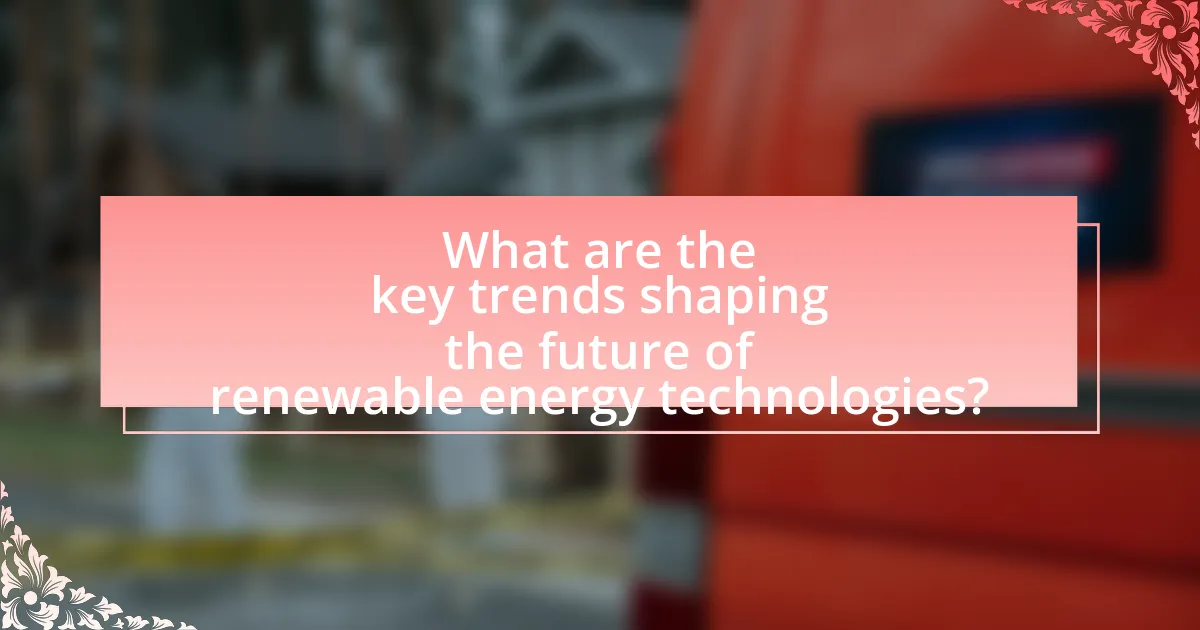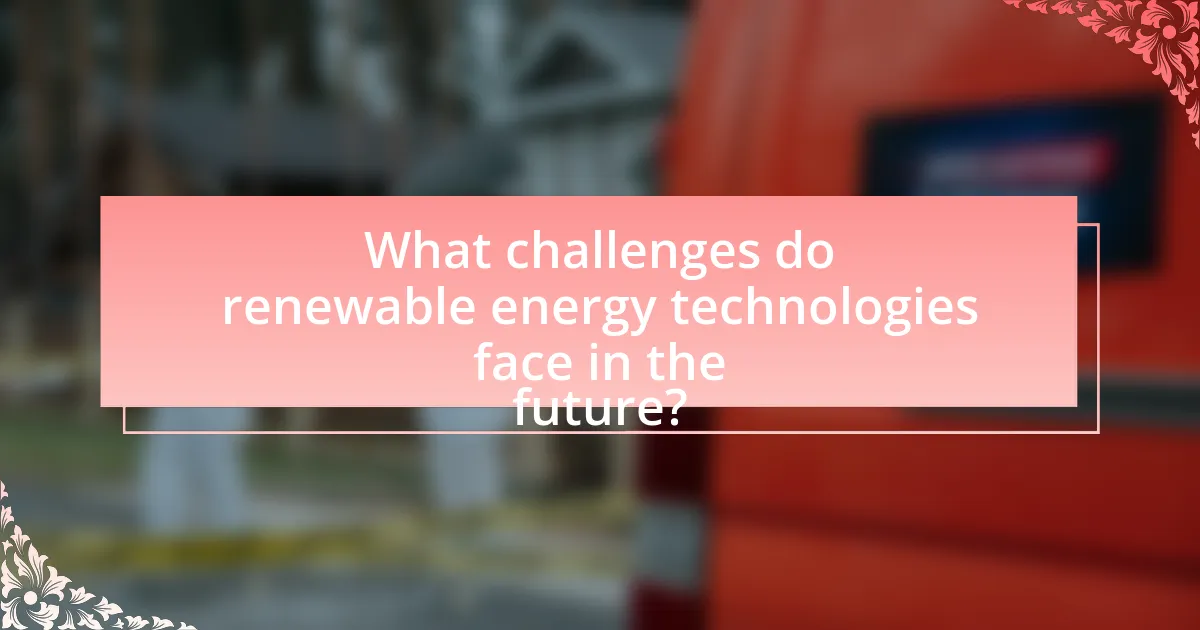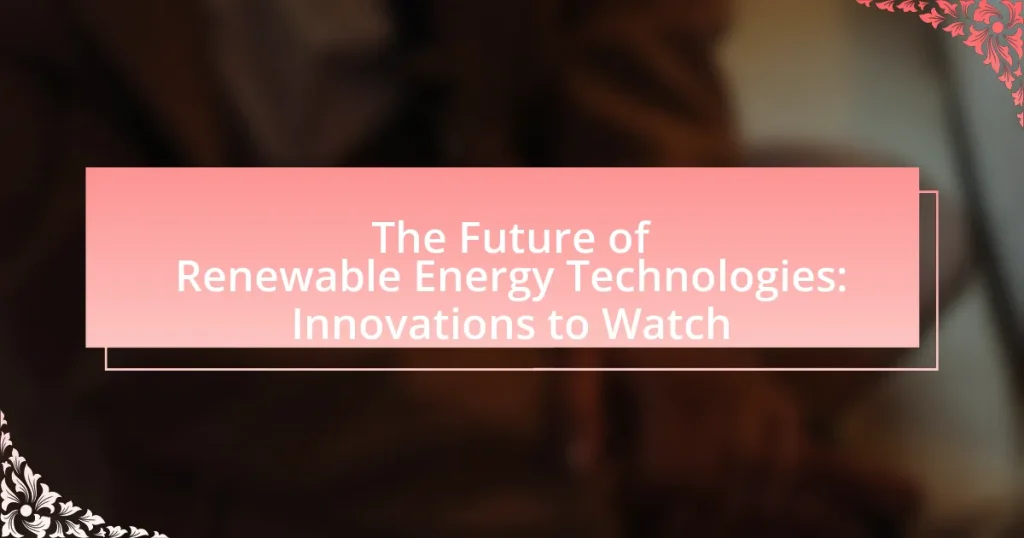The article focuses on the future of renewable energy technologies, highlighting key trends and innovations that are shaping the sector. It discusses advancements in energy storage, solar panel efficiency, and the integration of artificial intelligence in energy management, emphasizing their roles in enhancing sustainability and efficiency. The article also explores emerging technologies in solar and wind energy, the evolution of energy storage solutions, and the impact of regulatory frameworks on renewable energy adoption. Additionally, it addresses economic barriers, financing models, and practical steps individuals and businesses can take to embrace these innovations, providing a comprehensive overview of the current landscape and future potential of renewable energy technologies.

What are the key trends shaping the future of renewable energy technologies?
Key trends shaping the future of renewable energy technologies include advancements in energy storage, increased efficiency of solar panels, and the integration of artificial intelligence in energy management. Energy storage technologies, such as lithium-ion batteries, are evolving to provide longer-lasting and more efficient solutions, which is crucial for balancing supply and demand in renewable energy systems. For instance, the global battery storage market is projected to grow significantly, with a compound annual growth rate of over 30% from 2020 to 2027, according to a report by Fortune Business Insights. Additionally, solar panel efficiency has improved, with new technologies achieving over 25% efficiency rates, enhancing the viability of solar energy as a primary power source. Furthermore, the application of artificial intelligence in optimizing energy consumption and predicting energy needs is becoming increasingly prevalent, leading to smarter energy grids and reduced operational costs. These trends collectively indicate a transformative shift towards more sustainable and efficient renewable energy systems.
How are advancements in solar energy influencing the renewable sector?
Advancements in solar energy are significantly enhancing the renewable sector by increasing efficiency and reducing costs. For instance, the development of bifacial solar panels, which capture sunlight on both sides, has improved energy output by up to 20% compared to traditional panels. Additionally, innovations in solar energy storage, such as lithium-ion batteries, are enabling better integration of solar power into the grid, allowing for a more reliable energy supply. According to the International Renewable Energy Agency, the cost of solar photovoltaic systems has dropped by 82% since 2010, making solar energy more accessible and competitive with fossil fuels. These advancements not only promote the adoption of solar energy but also drive investment and research in other renewable technologies, fostering a more sustainable energy landscape.
What new technologies are emerging in solar energy production?
Emerging technologies in solar energy production include bifacial solar panels, perovskite solar cells, and solar tracking systems. Bifacial solar panels capture sunlight from both sides, increasing energy generation by up to 30% compared to traditional panels. Perovskite solar cells, made from a new class of materials, offer higher efficiency rates and lower production costs, with efficiencies exceeding 25% in laboratory settings. Solar tracking systems adjust the angle of solar panels throughout the day to follow the sun, enhancing energy capture by approximately 25% to 35%. These advancements are supported by ongoing research and development, indicating a significant shift towards more efficient and cost-effective solar energy solutions.
How do these advancements improve efficiency and cost-effectiveness?
Advancements in renewable energy technologies improve efficiency and cost-effectiveness by enhancing energy conversion rates and reducing operational costs. For instance, innovations such as bifacial solar panels can capture sunlight from both sides, increasing energy output by up to 27% compared to traditional panels. Additionally, advancements in wind turbine design, such as larger rotor diameters and improved materials, allow for greater energy capture at lower wind speeds, thereby maximizing energy production while minimizing installation and maintenance costs. These improvements lead to a decrease in the levelized cost of electricity (LCOE), making renewable energy sources more competitive with fossil fuels. According to the International Renewable Energy Agency (IRENA), the global weighted-average LCOE of solar photovoltaics fell by 89% between 2010 and 2020, demonstrating significant cost-effectiveness gains driven by technological advancements.
What role does wind energy play in future innovations?
Wind energy is pivotal in driving future innovations in renewable energy technologies. As the global demand for clean energy increases, advancements in wind turbine design, efficiency, and energy storage systems are emerging. For instance, the International Energy Agency reported that wind energy capacity has grown significantly, with a 53% increase in offshore wind installations from 2019 to 2020, showcasing the rapid technological advancements in this sector. Furthermore, innovations such as floating wind farms and enhanced grid integration are set to expand the geographical reach and efficiency of wind energy, making it a cornerstone of sustainable energy solutions.
What are the latest developments in wind turbine technology?
Recent advancements in wind turbine technology include the development of larger, more efficient turbines, enhanced materials for blades, and innovations in energy storage systems. For instance, manufacturers are producing turbines with rotor diameters exceeding 200 meters, which can capture more wind energy and increase energy output significantly. Additionally, the use of lighter and stronger composite materials for blades improves durability and performance, allowing for longer blades that can harness wind at lower speeds. Furthermore, integrating advanced energy storage solutions, such as lithium-ion batteries, with wind farms enables better management of energy supply and demand, enhancing the reliability of wind energy. These developments are supported by industry reports indicating that the global wind turbine market is projected to grow significantly, driven by technological innovations and increasing investments in renewable energy.
How is offshore wind energy evolving?
Offshore wind energy is evolving rapidly through advancements in technology, increased capacity, and expanded geographic deployment. Innovations such as larger turbine sizes, with some exceeding 12 megawatts, enhance energy generation efficiency and reduce costs. According to the Global Wind Energy Council, global offshore wind capacity reached over 35 gigawatts in 2020, with projections estimating it could exceed 234 gigawatts by 2030. Additionally, floating wind farms are being developed, allowing deployment in deeper waters where wind resources are stronger and more consistent. These developments indicate a significant shift towards offshore wind as a key player in the renewable energy landscape.
How is energy storage technology transforming renewable energy usage?
Energy storage technology is transforming renewable energy usage by enabling the efficient capture and utilization of energy generated from renewable sources like solar and wind. This technology addresses the intermittency of renewable energy, allowing for energy to be stored during peak production times and released during periods of high demand or low generation. For instance, advancements in lithium-ion batteries have led to a significant reduction in costs, with prices dropping by approximately 89% since 2010, according to BloombergNEF. This cost reduction has made energy storage systems more accessible and economically viable for both residential and commercial applications, thereby facilitating a greater integration of renewable energy into the grid. Additionally, energy storage enhances grid stability and reliability, supporting the transition to a more sustainable energy system.
What are the most promising energy storage solutions currently being developed?
The most promising energy storage solutions currently being developed include lithium-sulfur batteries, solid-state batteries, and flow batteries. Lithium-sulfur batteries offer higher energy density compared to traditional lithium-ion batteries, potentially increasing electric vehicle range and reducing costs. Solid-state batteries utilize a solid electrolyte, enhancing safety and energy density, with companies like Toyota and QuantumScape leading advancements in this area. Flow batteries, particularly vanadium redox flow batteries, provide scalable energy storage for renewable sources, allowing for long-duration energy discharge, which is crucial for grid stability. These technologies are backed by ongoing research and investment, indicating their potential to significantly impact energy storage in the near future.
How do these solutions address the intermittency of renewable sources?
Solutions to address the intermittency of renewable sources include energy storage systems, demand response strategies, and grid management technologies. Energy storage systems, such as batteries, allow excess energy generated during peak production times to be stored and released during low production periods, effectively balancing supply and demand. For instance, the global battery storage market is projected to reach 1,000 GWh by 2030, demonstrating significant investment in this technology. Demand response strategies enable consumers to adjust their energy usage based on availability, which helps to stabilize the grid during fluctuations in renewable energy generation. Additionally, advanced grid management technologies, including smart grids, enhance the ability to integrate diverse energy sources and optimize their use, thereby mitigating the effects of intermittency. These approaches collectively ensure a more reliable and resilient energy supply from renewable sources.

What challenges do renewable energy technologies face in the future?
Renewable energy technologies face several significant challenges in the future, including energy storage limitations, grid integration issues, and regulatory hurdles. Energy storage remains a critical barrier, as current battery technologies struggle to efficiently store large amounts of energy generated from intermittent sources like solar and wind. For instance, the International Energy Agency reported that energy storage capacity must increase significantly to support a global transition to renewable energy. Grid integration poses another challenge, as existing infrastructure often requires upgrades to accommodate the variable nature of renewable energy sources. Additionally, regulatory frameworks can hinder the deployment of renewable technologies, as inconsistent policies across regions can create uncertainty for investors and developers. These challenges must be addressed to ensure the successful advancement of renewable energy technologies.
How do regulatory frameworks impact the growth of renewable energy technologies?
Regulatory frameworks significantly influence the growth of renewable energy technologies by establishing the rules and incentives that govern the industry. These frameworks can promote investment through subsidies, tax credits, and renewable energy standards, which encourage the development and deployment of technologies such as solar and wind power. For instance, the U.S. federal Investment Tax Credit (ITC) has been pivotal in increasing solar energy installations, contributing to a 167% growth in solar capacity from 2016 to 2020. Additionally, clear regulations can streamline permitting processes, reduce uncertainty for investors, and foster innovation by setting ambitious renewable energy targets. In contrast, inconsistent or overly restrictive regulations can hinder growth by creating barriers to entry and increasing costs for developers. Thus, effective regulatory frameworks are essential for accelerating the adoption and advancement of renewable energy technologies.
What are the key policies affecting renewable energy adoption?
Key policies affecting renewable energy adoption include feed-in tariffs, renewable portfolio standards, tax incentives, and government grants. Feed-in tariffs guarantee fixed payments for energy producers, encouraging investment in renewable technologies. Renewable portfolio standards mandate that a certain percentage of energy must come from renewable sources, driving utilities to adopt cleaner energy. Tax incentives, such as the Investment Tax Credit and Production Tax Credit in the United States, reduce the financial burden on renewable energy projects, making them more attractive to investors. Government grants provide direct funding for research and development, facilitating innovation in renewable technologies. These policies collectively create a supportive environment for the growth and integration of renewable energy into the energy market.
How can governments support innovation in this sector?
Governments can support innovation in the renewable energy sector by providing funding for research and development initiatives. For instance, the U.S. Department of Energy allocated over $1 billion in 2021 to support clean energy technologies, demonstrating a commitment to advancing innovation. Additionally, governments can implement tax incentives for companies investing in renewable energy projects, which encourages private sector participation and accelerates technological advancements. Furthermore, establishing public-private partnerships can facilitate knowledge sharing and resource pooling, enhancing innovation capabilities. These strategies collectively foster an environment conducive to the growth of renewable energy technologies.
What are the economic barriers to widespread renewable energy adoption?
The economic barriers to widespread renewable energy adoption include high initial capital costs, lack of financial incentives, and market volatility. High initial capital costs deter investment in renewable technologies, as projects often require significant upfront funding; for instance, solar and wind installations can cost millions of dollars. Additionally, the absence of robust financial incentives, such as tax credits or subsidies, limits the attractiveness of renewable energy investments compared to fossil fuels, which often receive substantial government support. Market volatility further complicates the situation, as fluctuating energy prices can make it difficult for renewable energy projects to secure financing and achieve profitability. These factors collectively hinder the transition to renewable energy sources on a large scale.
How do initial investment costs compare to long-term savings?
Initial investment costs for renewable energy technologies are typically higher than traditional energy sources, but they lead to significant long-term savings. For example, solar energy systems can require an upfront investment of $15,000 to $30,000, depending on the size and installation, while the long-term savings can exceed $20,000 over 20 years due to reduced electricity bills and tax incentives. Additionally, studies show that renewable energy sources, such as wind and solar, have lower operational costs compared to fossil fuels, which further enhances long-term savings. According to the International Renewable Energy Agency, the levelized cost of electricity from renewables has decreased by 82% since 2010, making them increasingly cost-competitive and beneficial for long-term financial planning.
What financing models are emerging to support renewable energy projects?
Emerging financing models to support renewable energy projects include green bonds, power purchase agreements (PPAs), and crowdfunding. Green bonds are debt instruments specifically earmarked for funding environmentally friendly projects, with the global green bond market reaching over $1 trillion in issuance by 2021, indicating strong investor interest. Power purchase agreements allow developers to secure long-term contracts with buyers, providing revenue certainty and attracting investment; the global PPA market has seen significant growth, with over 20 gigawatts of renewable energy capacity contracted in 2020 alone. Crowdfunding platforms enable individual investors to contribute to renewable energy projects, democratizing investment and expanding access to capital, as evidenced by platforms like SolarCity and Mosaic, which have successfully funded numerous solar projects through community investment.

What innovations in renewable energy technologies should we watch for?
Innovations in renewable energy technologies to watch for include advancements in solar photovoltaic efficiency, energy storage solutions, and offshore wind energy systems. For instance, perovskite solar cells are emerging as a game-changer, potentially achieving efficiencies over 30% compared to traditional silicon cells, which typically max out around 22%. Additionally, solid-state batteries are being developed to enhance energy storage capacity and safety, addressing the limitations of current lithium-ion technology. Offshore wind energy is also evolving with floating turbine technology, allowing for installations in deeper waters, which can harness stronger and more consistent winds. These innovations are supported by ongoing research and development efforts, indicating a significant shift towards more efficient and sustainable energy solutions.
What are the most exciting breakthroughs in bioenergy?
Recent breakthroughs in bioenergy include advancements in algae-based biofuels, which have shown potential for high yield and low land use. Research from the National Renewable Energy Laboratory indicates that algae can produce up to 30 times more oil per acre than traditional crops. Additionally, the development of genetically engineered microorganisms for efficient biomass conversion has improved the conversion rates of lignocellulosic materials into sugars, enhancing the overall efficiency of biofuel production. These innovations are crucial for increasing the sustainability and viability of bioenergy as a renewable energy source.
How are new biofuel technologies being developed?
New biofuel technologies are being developed through advancements in feedstock selection, genetic engineering, and innovative conversion processes. Researchers are focusing on non-food biomass, such as agricultural waste and algae, to produce biofuels more sustainably. For instance, the use of genetically modified organisms can enhance the efficiency of biofuel production by increasing yield and reducing resource consumption. Additionally, processes like anaerobic digestion and thermochemical conversion are being optimized to convert organic materials into biofuels more effectively. These developments are supported by studies indicating that biofuels can significantly reduce greenhouse gas emissions compared to fossil fuels, making them a viable alternative in the transition to renewable energy sources.
What potential do algae and waste-to-energy processes hold?
Algae and waste-to-energy processes hold significant potential for sustainable energy production and environmental management. Algae can produce biofuels, which are renewable and can reduce greenhouse gas emissions; for instance, certain strains of algae can yield up to 30 times more oil per acre than traditional crops. Waste-to-energy processes convert organic waste into energy, reducing landfill use and generating electricity or heat; in 2020, the U.S. generated approximately 14.5 billion kilowatt-hours from municipal solid waste. Together, these technologies can contribute to a circular economy, enhance energy security, and mitigate climate change impacts.
How is hydrogen energy evolving as a renewable resource?
Hydrogen energy is evolving as a renewable resource through advancements in production methods, storage technologies, and applications in various sectors. The development of green hydrogen, produced via electrolysis using renewable energy sources, has gained significant traction, with global production capacity expected to reach 60 million tons by 2030, according to the International Energy Agency. Additionally, innovations in fuel cell technology are enhancing the efficiency and viability of hydrogen as a clean energy carrier, making it suitable for transportation, industrial processes, and power generation. The increasing investment in hydrogen infrastructure, such as pipelines and refueling stations, further supports its integration into the energy market, positioning hydrogen as a key player in the transition to a sustainable energy future.
What advancements are being made in hydrogen production and storage?
Advancements in hydrogen production and storage include the development of more efficient electrolysis methods, such as proton exchange membrane (PEM) electrolysis, which can achieve higher purity hydrogen at lower energy costs. Additionally, researchers are exploring the use of renewable energy sources, like solar and wind, to power hydrogen production, significantly reducing carbon emissions associated with traditional methods. In storage, innovations like metal hydrides and liquid organic hydrogen carriers are being investigated to enhance hydrogen density and safety, making it easier to transport and store hydrogen for various applications. These advancements are supported by ongoing research and investment in hydrogen technologies, indicating a strong trend towards sustainable hydrogen solutions in the renewable energy sector.
How can hydrogen contribute to a sustainable energy future?
Hydrogen can contribute to a sustainable energy future by serving as a clean energy carrier that can store and transport energy generated from renewable sources. When produced through electrolysis using renewable electricity, hydrogen emits no greenhouse gases during its use, making it a viable alternative to fossil fuels. According to the International Energy Agency, hydrogen could account for up to 18% of global energy demand by 2050, significantly reducing carbon emissions in sectors like transportation, industry, and heating. This potential is further supported by advancements in hydrogen fuel cell technology, which enhance efficiency and reduce costs, facilitating broader adoption across various applications.
What practical steps can individuals and businesses take to embrace renewable energy innovations?
Individuals and businesses can embrace renewable energy innovations by investing in solar panels and wind turbines. These technologies allow for the generation of clean energy, reducing reliance on fossil fuels. For instance, the U.S. Energy Information Administration reported that solar energy capacity increased by 167% from 2015 to 2020, demonstrating the growing feasibility and adoption of solar technology. Additionally, businesses can implement energy efficiency measures, such as upgrading to LED lighting and smart thermostats, which can reduce energy consumption by up to 30%. Individuals can also participate in community solar programs, allowing them to access renewable energy without needing to install equipment on their property. By taking these steps, both individuals and businesses contribute to a sustainable energy future while potentially lowering energy costs.


